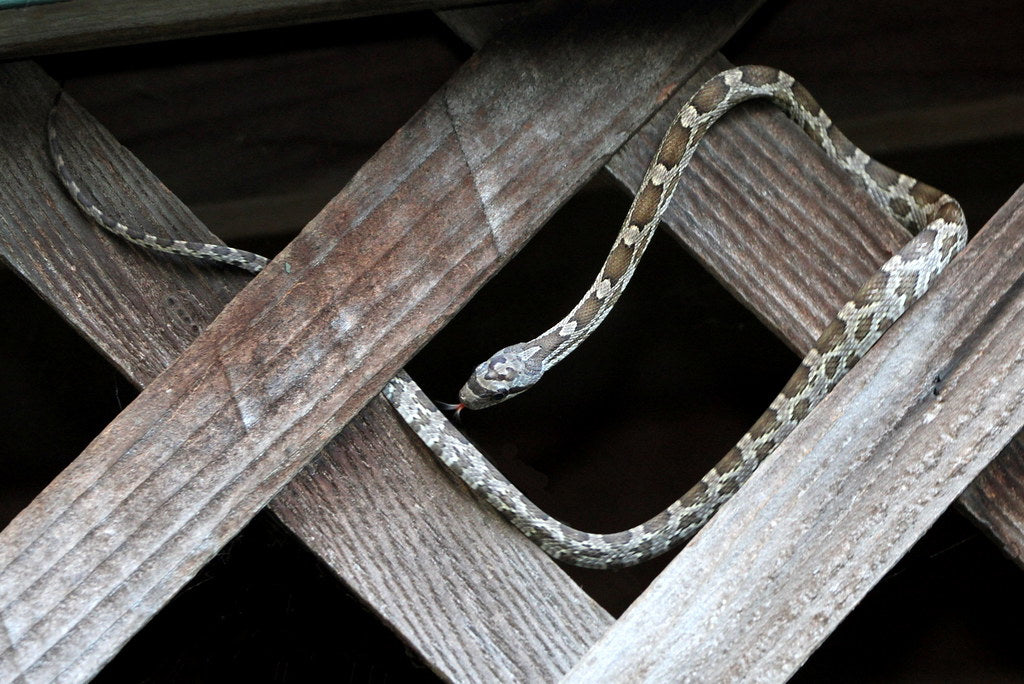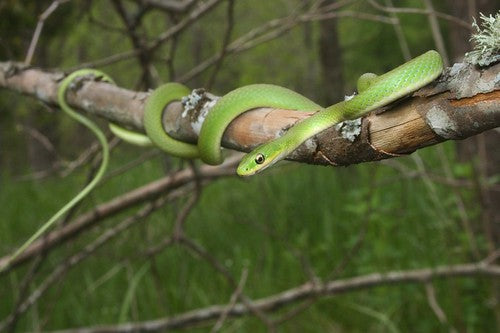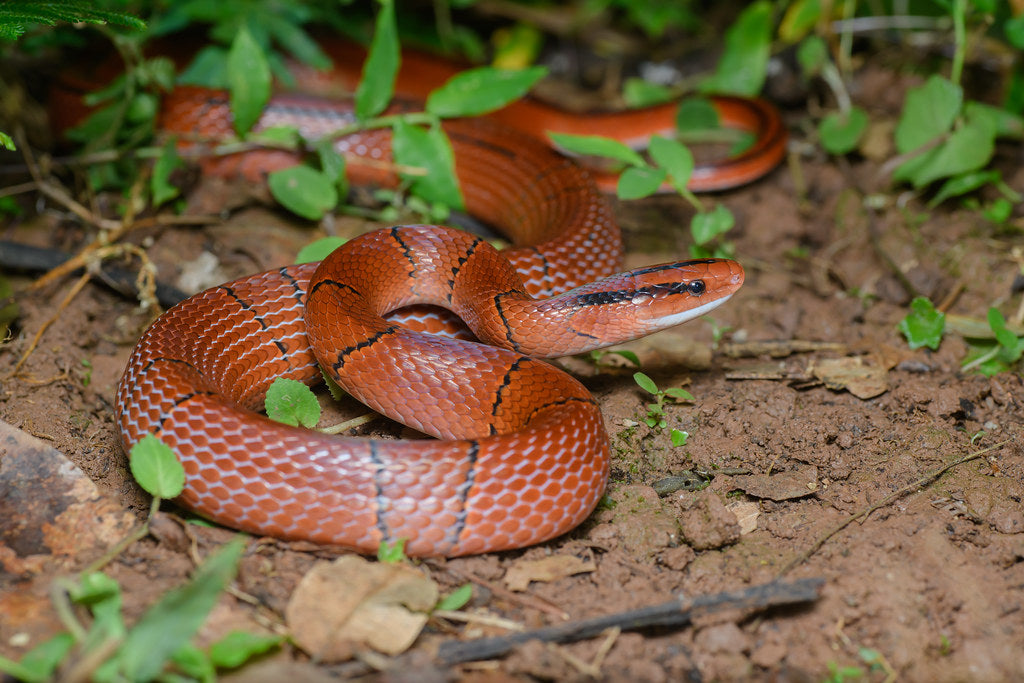Texas rat snakes (Elaphe obsoleta lindheimeri) are medium-sized, semi-arboreal snakes found primarily in Texas, Louisiana, and Oklahoma. They tend to prefer forested areas, but they can be found in bayou, swamp, stream valleys, and rocky canyons, as well as urban areas. This species is extremely active and adaptable, proficient at both climbing and swimming.
Texas rat snakes typically grow 3.5-6’ long, although longer is possible. They have a slender, muscular body and an oval-shaped head. Wild-type Texas rat snakes have a dark gray, brown, yellowish, or orange-ish base color with dark brown/black blotches down their back and pale lips/underside. There is known to be significant variation in appearance between localities, and other colors/patterns are available as captive-bred “morphs”.
Texas rat snakes make inquisitive, lively pets, and are fairly easy to care for. With appropriate care, they usually live 10-15 years, but 20+ is possible.
Rat snakes are very common in the US, but that does not mean it’s a good idea to capture one from the wild if you want one as a pet. Wild-caught snakes are often more stressed in captivity and often carry heavy parasite loads. Please buy captive-bred instead!
How much space do Texas rat snakes need?
Because Texas rat snakes are slender, many people think of them as smaller than they really are, keeping them in enclosures that are too small for them to stretch out fully, explore, and climb. The truth is that although they seem small, they’re still long, and extremely active. So the minimum for appropriately keeping one adult Texas rat snake is 48”L x 24”W x 24”H. This is just the minimum, so using larger dimensions is beneficial and will happily be used, especially for particularly large individuals.
Cohabitation (keeping multiple Texas rat snakes in one enclosure) is not recommended, as rat snakes are not a social species, and keeping them together is likely to cause negative stress.
Do Texas rat snakes need UVB?
They can survive without it, but it’s still best practice to provide UVB lighting for optimal health and wellbeing. UVB gives snakes all of the vitamin D that their bodies need, stimulates better appetite and activity, and generally allows them to be healthier than they would be without.
Texas rat snakes do best with low-strength UVB as part of their enclosure. The best UVB bulbs for Texas rat snakes are:
The UVB bulb should be housed in a reflective fixture and placed close to the heat lamp, about 9-11” above the basking area if over mesh, and 12-14” above the basking area if not. UVB is blocked by glass and plastic, so you can’t give your snake UVB by placing its terrarium in front of an open window. Also make sure that the fixture your UVB bulb is in does not have a clear plastic bulb cover.
Lights should be on for 13 hours/day during summer and 11 hours/day during winter. This helps encourage more natural hormonal rhythms and better health.
What basking temperatures do Texas rat snakes need?
Like other reptiles, Texas rat snakes are ectotherms, which means that they need a temperature gradient in their enclosure to help them regulate their metabolism and stay healthy.
Texas rat snakes should have a basking area temperature of around 86°F. On the other side of the enclosure, the temperature should be around 75°F. Temperatures should be measured with a digital probe thermometer, with the probe placed where you want to take the temperature.
Provide heat for your rat snake by imitating the sun with at least two halogen heat bulbs clustered on one side of the enclosure, positioned over a sturdy basking branch. Do not use ceramic heat emitters (CHEs), red bulbs, or blue bulbs, as these are not as effective.
What humidity levels do Texas rat snakes need?
Texas rat snakes are pretty flexible when it comes to preferred humidity levels, but it’s important to make sure that they have plenty of access to water so they can stay hydrated and shed properly. The best way to do this is by providing a moisture-retentive substrate and a humid hideout lined with moistened sphagnum moss.
Your Texas rat snake should also have access to a nice large water bowl/tub that they can soak their entire body in, and preferably swim in a bit as well.
If you live in a dry climate, it’s a good idea to occasionally mix some water into the substrate to slowly release moisture into the air. The substrate should be lightly damp, not soaked or muddy.
What substrate is good for Texas rat snakes?
Texas snakes require a 2-4” layer of substrate to cushion their bodies and provide a burrowing medium to use as desired. As an added perk, it also tends to make the enclosure more attractive.
Ideally, this substrate should resemble what Texas rat snakes naturally live on in the wild: soil. It should have small particles and hold moisture well. We recommend the following substrates for Texas rat snakes:
Substrate should be completely replaced every 3-4 months. Remove poop and urates daily, along with contaminated substrate.
What décor can you use in a Texas rat snake terrarium?
It’s terribly boring for a snake to be stuck in an enclosure with nothing in it except substrate, hides, and a water bowl — especially for one as inquisitive as the Texas rat snake. It doesn’t matter how big the enclosure is if you don’t put things in it for your pet to use and interact with.
Aside from hiding places, you will also need at least a couple of sturdy branches for your rat snake to climb on, as well as some live or artificial foliage to provide cover. Additional options include:
- leaf litter
- more branches
- cork tubes
- ledges
- live or artificial plants
What do Texas rat snakes eat?
Like other snakes, Texas rat snakes are carnivores, which means that they need to eat whole animal prey in order to get the nutrition that they need. Here is a basic feeding schedule based on snake size:
- Hatchlings should be fed once every 5-7 days.
- Juveniles should be fed once every 7-10 days.
- Adults should be fed once every 10-14 days.
Prey items should be around 10% of your snake’s weight and/or no more than 1.5x its width. Although live prey can be used, it’s safest and most humane to use frozen instead. Prey should be thawed in a plastic bag in warm water to approximately 100°F before offering with a pair of soft-tipped tweezers.
Remember, the key to great nutrition is variety! Aside from offering mice and rats, quail, chicks, feeder lizards, and quail/chicken eggs can also be used to create nutritional variety in your rat snake’s diet.
Supplements
Texas rat snakes can survive without vitamin or mineral supplements, but occasionally using them can help prevent nutritional deficiencies and optimize your snake’s health. We recommend Repashy Calcium Plus LoD.
Water
Your Texas rat snake should have access to clean, fresh water at all times. Provide a water bowl large enough for the snake to soak its entire body if desired. Change the water daily and scrub the bowl with a reptile-safe disinfectant weekly, or whenever it becomes soiled.
Do Texas rat snakes like to be handled?
Few reptiles actually “like” to be held, but captive-bred Texas rat snakes generally tolerate handling well. Note, however, that they can be particularly squirmy as juveniles, and are prone to musking or striking when they feel threatened. Be gentle, and scoop up the snake from below rather than from above. Support as much of its body as possible, let it slither around, and NEVER pick up a snake by its tail!
*This care sheet contains only very basic information. Although it’s a good introduction, please do further research with high-quality sources to obtain additional information on caring for this species.
"Texas Rat Snake 01" by TexasEagle is licensed under CC BY-NC 2.0




Leave a comment
This site is protected by hCaptcha and the hCaptcha Privacy Policy and Terms of Service apply.